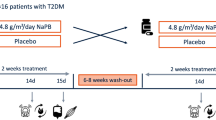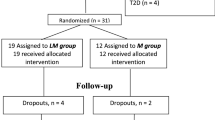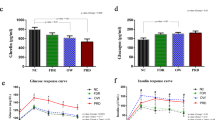Abstract
BACKGROUND: Circulating lymphocytes of obese individuals with and without type 2 diabetes have derangements of pyruvate dehydrogenase (PDH) that are described as reflecting a disorder underlying systemic insulin resistance, namely basal activity below normal and, in vitro, unresponsiveness to insulin at 33 pmol/l and activation at 330 pmol/l instead of activation and inhibition as in controls.
OBJECTIVE: To explore whether the above enzyme derangements are overcome in obese individuals on dexfenfluramine treatment, known to improve poor peripheral insulin sensitivity.
METHODS: Fifteen obese diabetic patients and 15 age-matched euglycaemic obese subjects with normal glucose tolerance were enrolled for a trial composed of two 21-day periods; in the first (D-21–D0), participants received a placebo, and in the second (D0–D21), dexfenfluramine (30 mg/day). At D-21, D0 and D21 participants were evaluated for weight, BMI, fasting glycaemia (FG), fasting insulinaemia (FI), fasting insulin resistance index (FIRI), area under the glycaemic (G-AUC) and insulinaemic (I-AUC) curves from an OGT test, and for PDH activity assayed in their circulating lymphocytes before (basal activity) and after incubation with 33 or 330 pmol/l insulin. At D2, basal PDH activity and clinical parameters were assayed.
RESULTS: In both groups of participants at D0 all parameters tested were constant with respect to D-21; at D2, only basal PDH activity rose significantly; at D21, basal and insulin stimulated PDH activities were normalized and weight decreased significantly, as did FG, FI, FIRI and G-AUC in the diabetic, and FI, FIRI, G-AUC and I-AUC in the non-diabetic participants.
CONCLUSION: In obese, non-diabetic and diabetic individuals on dexfenfluramine treatment, amelioration of clinical parameters and indexes of poor insulin sensitivity of blood glucose homeostasis are preceded by correction, in their circulating lymphocytes, of PDH derangements described as reflecting a disorder underlying insulin resistance.
This is a preview of subscription content, access via your institution
Access options
Subscribe to this journal
Receive 12 print issues and online access
$259.00 per year
only $21.58 per issue
Buy this article
- Purchase on Springer Link
- Instant access to full article PDF
Prices may be subject to local taxes which are calculated during checkout



Similar content being viewed by others
References
Curto M, Novi RF, Rabbone I, Maurino M, Piccinini M, Mioletti S, Mostert M, Bruno R, Rinaudo MT . Insulin resistance in obese subjects and newly diagnosed NIDDM patients and derangements of pyruvate dehydrogenase in their circulating lymphocytes Int J Obes Relat Metab Disord 1997 21: 1137–1142.
Curto M, Piccinini M, Bruno R, Mostert M, Rinaudo MT . Insulin modulation of pyruvate dehydrogenase in human circulating lymphocytes Int J Biochem 1988 20: 1211–1217.
Curto M, Piccinini M, Cerutti F, Rabbone I, Mostert M, Sacchetti C, Bruno R, Rinaudo MT . The insulin signal and its effects on the pyruvate dehydrogenase complex in circulating lymphocytes of obese children Int J Biochem 1992 24: 831–837.
Rabbone I, Piccinini M, Curto M, Mostert M, Gamba S, Mioletti S, Bruno R, Rinaudo MT . Molecular effects of sulfonylurea agents in circulating lymphocytes of patients with non-insulin-dependent diabetes mellitus Br J Clin Pharmacol 1995 45: 291–299.
Wieland OH . The mammalian pyruvate dehydrogenase complex: structure and regulation Rev Physiol Biochem Pharmacol 1983 96: 123–170.
Wieland OH, Patzelt C, Löffler G . Active and inactive forms of pyruvate dehydrogenase in rat liver. Effect of starvation and refeeding and of insulin treatment on pyruvate dehydrogenase interconversion Eur J Biochem 1972 26: 426–433.
Wieland OH, Siess E, Schulze-Wethmar FH, Von Fimcke HG, Winton B . Active and inactive forms of pyruvate dehydrogenase in rat heart and kidney. Effect of diabetes, fasting and refeeding on pyruvate dehydrogenase interconversion Arch Biochem Biophys 1972 143: 593–601.
Stansbie D, Denton RM, Bridges BJ, Pask HT, Randle PJ . Regulation of pyruvate dehydrogenase and pyruvate dehydrogenase phosphate phosphatase activity in rat epididymal fat-pads Biochem J 1976 154: 225–236.
Popp DA, Kiechle FL, Kotagal N, Jarett L . Insulin stimulation of pyruvate dehydrogenase in an isolated plasma membrane-mitochondrial mixture occurs by activation of pyruvate dehydrogenase phosphatase J Biol Chem 1980 255: 7540–7543.
Lilley K, Zhang C, Villar-Palasi C, Larner J, Huang L . Insulin mediator stimulation of pyruvate dehydrogenase phosphatase Arch Biochem Biophys 1992 296: 170–174.
Pestell RG, Crock AP, Ward GM, Alford FP, Best JD . Fenfluramine increases insulin action in patients with NIDDM Diabetes Care 1989 12: 252–258.
Scheen AJ, Paolisso G, Salvatore T, Lefèbvre PJ . Improvement of insulin-induced glucose disposal in obese patients with NIDDM after 1-wk treatment with d-denfluramine. Diabetes Care 1991 14: 325–332.
Andersen PH, Richelsen B, Bak J, Schmitz O, Sorensen N, Lavielle R, Pedersen O . Influence of short-term dexfenfluramine therapy on glucose and lipid metabolism in obese non-diabetic patients Acta Endocrinol 1993 128: 251–258.
Proietto J, Thorburn AW, Fabris S, Harrison LC . Effects of dexfenfluramine on glucose turnover in non-insulin-dependent diabetes mellitus Diabetes Res Clin Pract 1994 23: 127–134.
Holdaway IM, Wallace E, Westbrooke L, Gamble G . Effect of dexfenfluramine on body weight, blood pressure, insulin resistance and serum cholesterol in obese individuals Int J Obes Relat Metab Disord 1995 19: 749–751.
Chow CC, Ko GT, Tsang LW, Yeung VT, Chan JC, Cockram CS . Dexfenfluramine in obese Chinese NIDDM patients. A placebo-controlled investigation of effects on body weight, glycemic control, and cardiovascular risk factors Diabetes Care 1997 20: 1122–1127.
Russel JC, Dolphin PJ, Graham SE, Amy RM, Brindley DN . Improvement of insulin sensitivity and cardiovascular outcomes in the JCR:LA-cp rat by D-fenfluramine Diabetologia 1998 41: 380–389.
National Diabetes Data Group . Classification and diagnosis of diabetes mellitus and other categories of glucose intolerance Diabetes 1979 28: 1039–1045.
Le Floch JP, Escuyer P, Baudin E, Baudon D, Perlemuter L . Blood glucose area under the curve. Methodological aspects Diabetes Care 1990 13: 172–175.
Duncan MH, Singh BM, Wise PH, Carter G . A simple measure of insulin resistance Lancet 1995 346: 120–121.
Tango T . Estimation of normal ranges of clinical laboratory data Stat Med 1986 5: 335–346.
Armitage P, Berry GD . Statistical methods in medical research Blackwell Scientific: Oxford 1994, pp 154–174.
Saltiel AR . Second messengers of insulin action Diabetes Care 1990 13: 244–256.
White MF, Kahn CR . The insulin signaling system J Biol Chem 1994 269: 1–4.
Denton RM, Tavaré JM . Does mitogen activated-protein kinase have a role in insulin action? The cases for and against Eur J Biochem 1995 227: 597–611.
Heesom KJ, Harbeck M, Kahn CR, Denton RM . Insulin action on metabolism Diabetologia 1997 40: B3–B9.
Cohen P, Alessi DR, Cross DEA . PDK1, one of the missing links in insulin signal transduction? (The Tenth Datta Lecture.) FEBS Lett 1997 410: 3–10.
Curto M, Piccinini M, Rabbone I, Mioletti S, Mostert M, Bruno R, Rinaudo MT . G proteins and regulation of pyruvate dehydrogenase activity by insulin in human circulating lymphocytes Int J Biochem Cell Biol 1997 29: 1207–1217.
Ward GL, Harrison C, Proietto J, Aitken P, Nankervis A . Gliclazide therapy is associated with potentiation of post-binding insulin action in obese, non-insulin-dependent diabetic subjects Diabetes 1985 34: 241–245.
Bonora E, Moghetti P, Querena M, Zenere M, Cacciatori V, Tosi F, Travia D, Zoppini G, Muggeo M . Studies on the mechanism of action of sulphonylureas in type II diabetic subjects: gliquidone J Endocrinol Invest 1992 15: 1–11.
Taylor SI, Cama A, Accili D, Barbetti F, Quon MJ, de la Luz Sierra M, Suzuki I, Koller E, Lavy-Toledano R, Wertheimer E . Mutations in the insulin receptor gene Endocr Rev 1992 13: 566–595.
Häring HU, Mehnert H . Pathogenesis of type 2 (non-insulin-dependent) diabetes mellitus: candidates for a signal transmitter defect causing insulin resistance of the skeletal muscle Diabetologia 1996 36: 176–183.
Kahn CR, Vicent D, Doria A . Genetics of non-insulin-dependent diabetes mellitus A. Rev. Med. 1996 47: 509–531.
Kellerer M, Mushack J, Seffer E, Mischak H, Ulrich A, Häring HU . Protein kinase C isoforms α, δ, θ require insulin receptor substrate-1 to inhibit the tyrosine kinase activity of the insulin receptor in human kidney embryonic cells (HEK 293 cells) Diabetologia 1998 41: 833–838.
Bindoff LA, Birch-Machin MA, Farnsworth L, Gardner-Medwin D, Lindsay JG, Turnbull DM . Familial intermittent ataxia due to a defect of the E1 component of pyruvate dehydrogenase complex J Neurol Sci 1989 93: 311–318.
Wexler ID, Hemalatha SG, Liu T-C, Berry SA, Kerr DS, Patel MS . A mutation in the E1-alpha subunit of pyruvate dehydrogenase associated with variable expression of pyruvate dehydrogenase complex deficiency Pediat Res 1992 32: 169–174.
Brown GK, Otero LJ, LeGris M, Brown RM . Pyruvate dehydrogenase deficiency J Med Genet 1994 31: 875–879.
Brown RM, Otero LJ, Brown GK . Transfection screening for primary defects in the pyruvate dehydrogenase E1-alpha subunit gene Hum Molec Genet 1997 6: 1361–1367.
DeMeirleir L, Specola N, Seneca S, Lissens W . Pyruvate dehydrogenase E1-alpha deficiency in a family: different clinical presentation in two siblings J Inherit Metab Dis 1998 21: 224–226.
Kelley DE, Mokan M, Mandarino LJ . Intracellular defects in glucose metabolism in obese patients with NIDDM Diabetes 1992 41: 698–706.
Bryson JM, King SE, Burns CM, Swaraj S, Caterson ID . Low fat diet-induced weight loss improves oxidative and non-oxidative glucose disposal Diabetologia 1996 39 (Suppl 1): 573 (abstract).
Mandarino LJ, Madar Z, Kolterman OI, Bell JM, Olefsky JM . Adipocyte glycogen synthase and pyruvate dehydrogenase in obese and type II diabetic subjects Am J Physiol 1986 251: (Endocrinol Metab 14): E489–496.
Randle PJ . Metabolic fuel selection: general integration at the whole-body level Proc Nutr Soc 1995 54: 317–327.
Sugden MC, Orfali KA, Holness MJ . The pyruvate dehydrogenase complex: nutrient control and the pathogenesis of insulin resistance J Nutr 1995 125 (Suppl): 1746S–1752S.
Garattini S, Mennini TR, Samanin R . From dexfenfluramine racemate to d-dexfenfluramine. Specificity and potency of the effects on the serotoninergic system and food intake Ann NY Acad Sci 1982 499: 156–166.
Acknowledgements
The authors are indebted to the Institute des Recherches Internationales Servier, I.R.I.S. (Paris, France) for financial support to the study. The work was in part performed with a financial grant from Ministero dell’ Università e della Ricerca Scientifica e Tecnologica -Italy.
Author information
Authors and Affiliations
Corresponding author
Rights and permissions
About this article
Cite this article
Piccinini, M., Rabbone, I., Novi, R. et al. In obese individuals dexfenfluramine corrects molecular derangements reflecting insulin resistance. Int J Obes 24, 735–741 (2000). https://doi.org/10.1038/sj.ijo.0801212
Received:
Revised:
Accepted:
Published:
Issue Date:
DOI: https://doi.org/10.1038/sj.ijo.0801212



